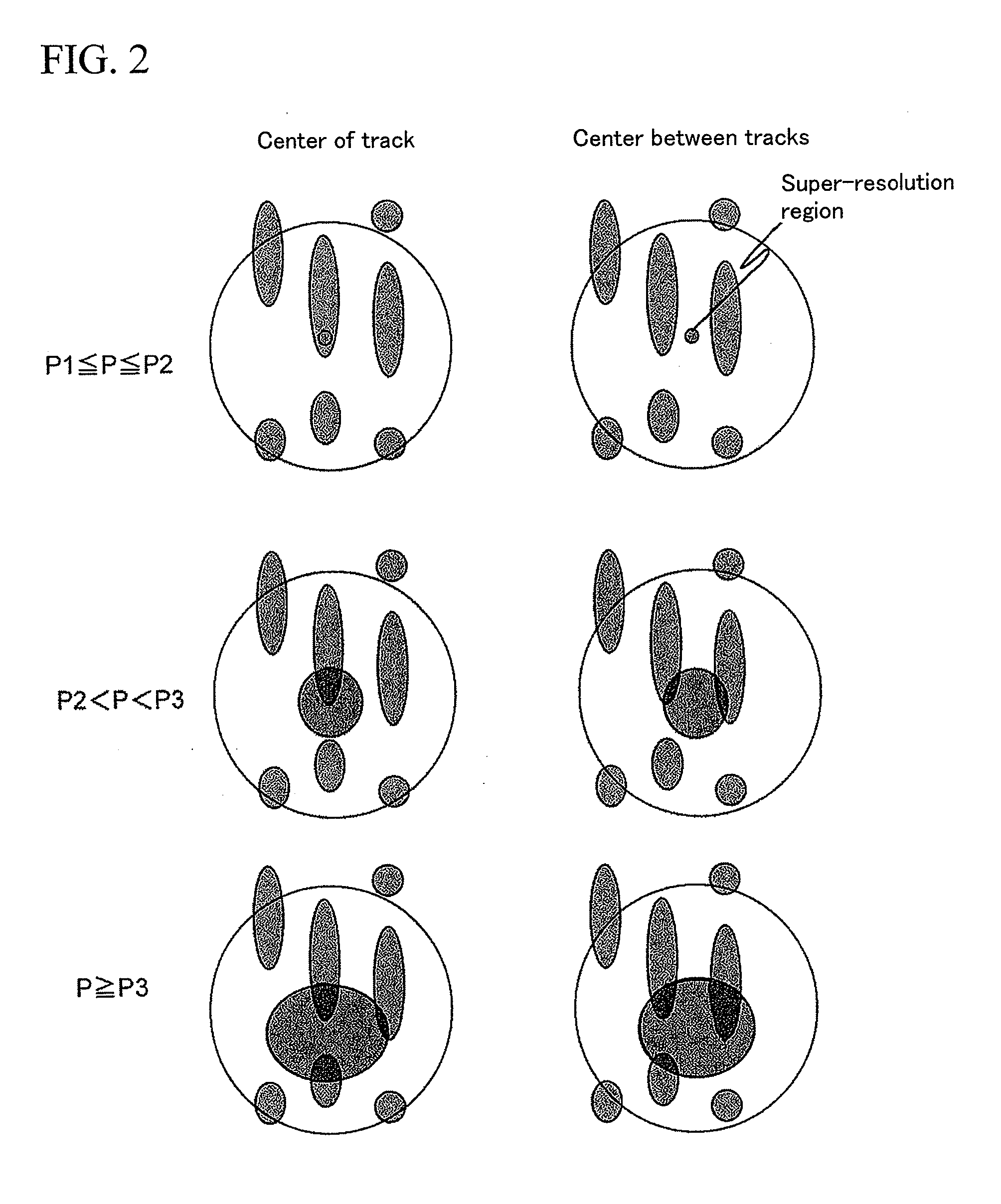Optical information reproducing method, optical information reproducing device, and optical information recording medium
a technology of optical information and reproducing method, which is applied in the field of high-capacity optical disc techniques, can solve the problems of increasing the bit error rate, insufficient amplitude for carrying out stable tracking servo, etc., and achieves the effect of increasing the density and capacity of recording data
- Summary
- Abstract
- Description
- Claims
- Application Information
AI Technical Summary
Benefits of technology
Problems solved by technology
Method used
Image
Examples
first embodiment
[0041]As a first embodiment, a case where the upper and lower levels of an envelope of a cross track signal are observed is described.
[0042]First, a method for fabricating a disc is described hereinafter. Here, the case of a ROM disc is described. In order to fabricate the ROM disc, data is recorded using an electron beam lithography apparatus. An electron beam resist is applied in a thickness of 100 nm onto a silicon substrate. A pattern corresponding to a recording data is drawn with an electron beam while rotating the substrate. The modulation code used here is 1-7 PP with a time window width of 25 nm, and the shortest mark length is 50 nm. The mark width is set to 100 nm and the track pitch is set to 200 nm. The recording data includes the values of P2 and P3 shown in FIGS. 1A and 1B. This data is recorded in regions of 24 mm and 58 mm radially from the center of the disc. Furthermore, in the disc radius from 25 mm to 25.5 mm and the disc radius from 57.5 mm to 58 mm, a predeter...
second embodiment
[0052]Next, a second embodiment is described. Here, a means for observing the amplitude of a cross track signal is described.
[0053]The disc is fabricated using the same method as the first embodiment. Moreover, the configuration of the drive is the same as the first embodiment except the signal processing and control system 312 of FIG. 3.
[0054]The disc is rotated inside the drive as in the first embodiment, and the data regarding the values of P2 and P3 recorded on the disc is read and then the light spot is moved to a portion in which the predefined data sequence is recorded.
[0055]The cross track signal is acquired as in the first embodiment, and the amplitude thereof is calculated in the signal processing and control system 312. As in the first embodiment, the differential coefficient of the amplitude of the cross track signal when the reproduction power is increased from 2.0 mW to 3 mW by a step increment of 0.05 mW is calculated. Here, as in the first embodiment, let the amplitu...
third embodiment
[0061]In the process of detecting a cross track signal while increasing the reproduction power in order to identify P2 and P3 in the third embodiment, the push-pull signal is detected at the same time. The push-pull signal described here is a value normalized by a total quantity of signals. In the drive used here, it is known that if the amplitude of the push-pull signal is greater than 1.5 V, the tracking servo is sufficiently stabilized, but the reproduction power at which the amplitude of the push-pull signal becomes greater than 1.5 V is in the range from 2.45 mW to 2.7 mW.
[0062]The tracking servo is applied at 2.45 mW, and the reproduction power is increased up to 2.7 mW by a step increment of 0.05 mW, and when the bit error rate of a mark sequence having a predetermined pattern is measured, the bit error rate becomes the minimum at 2.65 mW. Thus, the optimum reproduction power is determined as 2.65 mW.
[0063]Furthermore, a fifth embodiment is described. Here, the optimum reprod...
PUM
| Property | Measurement | Unit |
|---|---|---|
| diameter | aaaaa | aaaaa |
| diameter | aaaaa | aaaaa |
| diameter | aaaaa | aaaaa |
Abstract
Description
Claims
Application Information
 Login to View More
Login to View More - R&D
- Intellectual Property
- Life Sciences
- Materials
- Tech Scout
- Unparalleled Data Quality
- Higher Quality Content
- 60% Fewer Hallucinations
Browse by: Latest US Patents, China's latest patents, Technical Efficacy Thesaurus, Application Domain, Technology Topic, Popular Technical Reports.
© 2025 PatSnap. All rights reserved.Legal|Privacy policy|Modern Slavery Act Transparency Statement|Sitemap|About US| Contact US: help@patsnap.com



